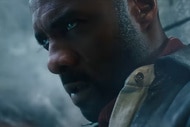Create a free profile to get unlimited access to exclusive videos, sweepstakes, and more!
Book vs. Flick: Pet Sematary

Pet Sematary is one of the best-beloved horror novels of all time, and the extreme trauma that methodically destroys the people at the heart of the tale has long since become a time-honored classic. The central that wishing for the dead to return can only turn into a Monkey’s Paw situation is forever relevant, and the commentary on how parents deal with the loss of a child will never lack poignancy.
Taking place in King’s beloved forests of Maine, the story focuses on a family that seeks to enjoy a more leisurely life with no respect for the land to which they're moving. This book, as well as its subsequent film adaptations, act mostly as warnings: do not wish for life after death, do not tamper with the forces of nature, and do not toy with things beyond your control. Now the subject of not just one well-loved classic horror film but a remake as well, Pet Sematary is still finding new audiences some 36 years after its original publication.
The plot is fairly straightforward — a doctor named Louis and his wife Rachel move from Boston to a small town in Maine to take it easy and escape city life, not understanding that there are many ancient threats at play in the woods around them. They discover a Pet "Sematary" on their property, and when their cat is hit by a truck, their neighbor Jud shows Louis a special place to bury the cat, who returns to life. The cat, named Church, does not come back the same, however, and this is our first glimpse that this family is in over their heads.When their young child Gage is hit by a semi-truck, Rachel and Louis are understandably devastated. Despite acknowledging that the cat was changed, and regardless of the obvious downside of bringing a creature back from the dead, Louis digs up Gage’s body and buries it in the Pet Sematary, only for Gage to return as a monstrous entity out for blood.
Pet Sematary fits nicely into Stephen King’s early-to-mid-’80s output, which, for this reader, was his prime. King’s tendency to overwrite and under-edit and his mean-spirited descriptives go a bit off the rails after this, and it still took more than a decade for him to begin writing queer and female characters with greater sympathy. Portrayals of Black people and other people of color, specifically Native Americans in this book, might never improve. There has been a great deal of study and criticism of how depicting Native Americans as being an ancient mystical force rather than a current, living, thriving people is extremely dangerous. The way this narrative places them as the foundation of the novel while entirely silencing them and failing to address why this white family building a house on their land is actually a horrific tragedy is, obviously, not great.
That said, if one reads through the story logically and with an eye on human history, the comeuppance of this family can serve as a warning to show greater respect to the lives that were extinguished. The fact of the matter is that manifest destiny is a tragically flawed concept that only leads to massive bloodshed and destruction —and it's at the heart of this plot, whether the writers behind the story and its adaptations acknowledge it or not. The central message of “sometimes dead is better” is certainly placed at the forefront, but sometimes, dead is actually not better. Sometimes it’s an atrocity that never needed to occur at all.
No doubt the greatest fear for many parents is that the moment they let their guards down, something terrible will happen to their child. The mix of grief and self-loathing that comes from losing a child in such a senseless, tragic way is truly a nightmare. In Pet Sematary, King, also a parent at the time, goes fully for his audience’s heartstrings, not just tugging on them but attempting to tear them out entirely. In this, the novel is highly successful. As obnoxious as the central white people of the story can be, it is very nearly impossible to not feel an overriding sympathy for parents who lose their children. Also, if you are a cat lover, this is a book that is going to wreck you. We recognize the zombified Church as an undead monster, but he is still a cat, and watching bad things happen to him is very difficult.
The throughline of Louis' atheism driving his desire to return his child to life is interesting, too. It is indeed the doctor’s lack of belief in an afterlife of any kind that drives him to bring his child back — because in his heart he believes that otherwise, they will be lost to him forever. While this may be slightly grating to atheists, most of whom would be highly unlikely to attempt to zombify their children due to their own personal belief system, it does add a bit of context as to where King is coming from in his work.The 1989 version of the story, directed by Mary Lambert, is a well-loved horror classic, and though parts of it haven’t aged well, there is no question as to why it hit audiences so hard. The traumatic scenes of young Gage's tragic death and the way that destroys Rachel inside will never stop being effective. Lambert worked closely with King, and the resulting film is a fairly accurate adaptation of the book. Much the same as the book, Louis ultimately kills Gage, and then is left with a zombified Rachel to deal with.
In both versions of the film, the genuine and interesting friendship between Louis and Jud is significantly reduced to the point of being nonexistent, but there is an entire novel to read if it interests you. At any rate, Jud is still a highly likable character, despite his mistake of taking Louis to the Pet Sematary to begin with.
Standard criticisms of the new film abound. Yes, it had a bigger budget, with a more aesthetically beautiful take on the film, and it thus lacks much of the grit of the original. Besides that, the plotlines are edged in sideways without context, so the audience is left wondering what exactly sister Zelda’s story even has to do with the plot at hand. Yet, the new film's issues are much the same as the previous adaptation, and no movie could fully encapsulate the horrific suffering she and Rachel experience with one another without that becoming the central focus of the story — but to omit it would be to misunderstand Rachel’s motivations. It’s a difficult place to be in.
The 2019 remake is essentially a more concise, modernized take, but if there is anything wrong with this rendition, it’s only that it slightly flattens the tragedies of these characters and fails to readdress tropes at play in the book and prior film that are now so well-known to the public consciousness that they have become the satirical subject matter of The Simpsons: Treehouse of Horror episodes.
The new film makes some small changes to add a bit of new horror for old audiences who have watched and rewatched the original adaptation. Since it’s new to theaters at the time of this writing, I’ll leave the spoilers on the cutting room floor, but there are a few new twists to be found. Not to mention, the cinematography is excellent, and the opening scene is gorgeous and ominous, just how horror movies are meant to be.
As with all Stephen King books, the social commentary is very seldom self-aware, and we take lessons from it beyond what were perhaps intended by the author. The ominous “ancient Native burial ground” explanation for the evils at hand don’t do any favors to the Natives who are still with us today, and the commentary on disability leaves something to be desired. That said, this is a story about catastrophic loss, and the myriad ways in which we deal with death. Any way you go, our promise to you is that we will not be burying anyone or anything in any Pet "Sematarys" anytime soon.



























